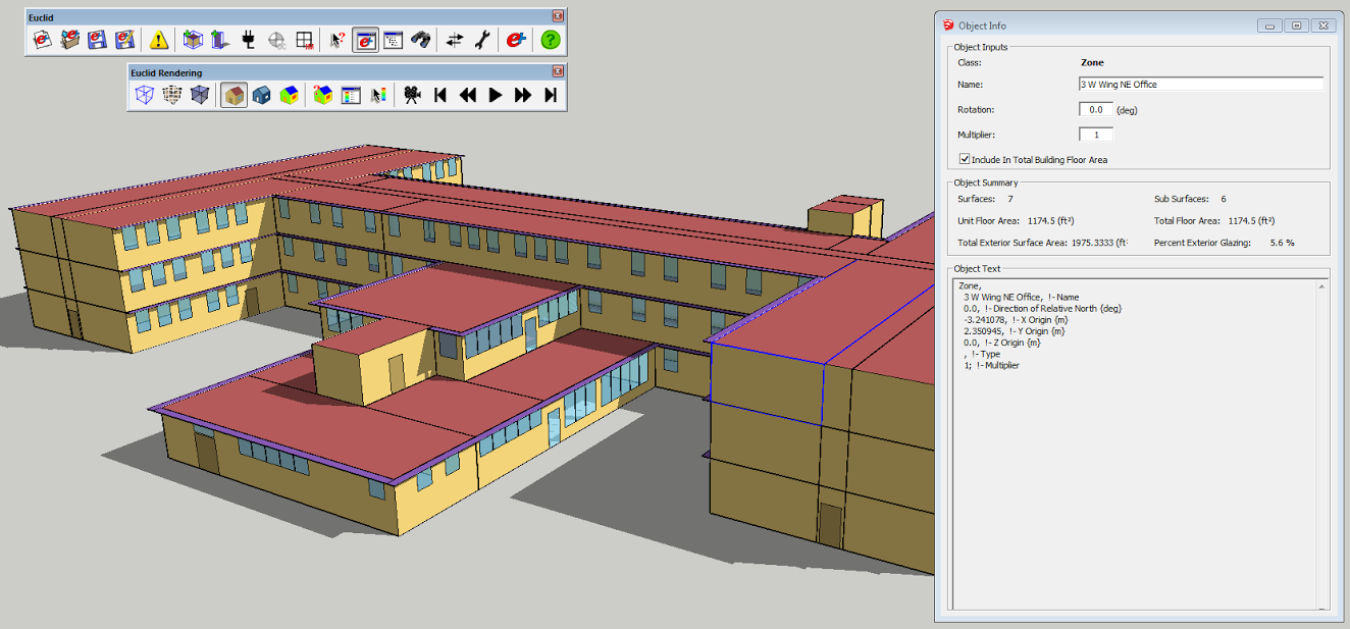The original OpenStudio—the EnergyPlus SketchUp plug-in—is going home. Big Ladder Software is taking over the tool, which is being rebranded Euclid.
May 9, 2017
The Legacy OpenStudio SketchUp plug-in contributed to the adoption of EnergyPlus and led to the development of the OpenStudio platform. Big Ladder Software is taking over the tool, appropriately re-branding it "Euclid".
DOE’s whole-building energy modeling (BEM) program is structured around the development and maintenance of two open-source software packages. EnergyPlus™ is a BEM physics engine. OpenStudio™ is a software development kit (SDK), a “wrapper” that makes it easier for developers to integrate EnergyPlus into applications and services. The OpenStudio package also includes demonstration applications—a geometry plug-in for the drawing program SketchUp, a graphical editor for non-geometry model inputs such as HVAC systems, and a parametric analysis tool. OpenStudio has been instrumental in the recent success of EnergyPlus and rightly shares twin billing, but its beginnings were more modest.
OpenStudio started in 2006 as a direct-to-EnergyPlus geometry plug-in for SketchUp. The plug-in was originally written at NREL by engineer Peter Ellis and was designed to make geometry creation easier and less error prone. Prior to OpenStudio, the most common way to create EnergyPlus geometry was to enter three-dimensional surface coordinates in a text editor—one vertex at a time. OpenStudio was quick to make an impact both in the field and at NREL. With SketchUp’s popularity and ease-of-use, EnergyPlus adoption started to grow. This success convinced NREL to continue investing in EnergyPlus productivity tools and to pursue the larger OpenStudio strategy. More subtly, but just as importantly, OpenStudio started a tradition of open-source development at NREL, a tradition which has since taken hold at DOE and has become standard practice for DOE BEM software projects.
The intervening years saw multiple significant changes. Ellis left NREL to start Big Ladder Software, an energy modeling software consultancy. The OpenStudio project evolved into its current, larger role as a Software Development Kit (SDK). The plug-in was re-engineered to target the OpenStudio SDK and the direct-to-EnergyPlus plug-in was renamed Legacy OpenStudio—overloading the name OpenStudio and causing confusion that has only recently started to dissipate. SketchUp itself changed hands several times. Google acquired SketchUp developer @Last Software in 2006 and then sold SketchUp to engineering equipment maker Trimble Navigation in 2012. The latter became especially significant when Trimble made SketchUp no longer free for commercial use. This allowed Trimble to provide a higher level of service for SketchUp but also pushed DOE to discontinue funding the development of Legacy OpenStudio. DOE certainly wants commercial applications and services to connect to its tools, but prefers that those connections be developed by the market. DOE wants to avoid using “directed” funds—funds that are not competitively awarded—to give preferential treatment to one company over another. As SketchUp and EnergyPlus kept advancing, Legacy OpenStudio remained static—unable to keep up with new features and bug fixes in both products—waiting for a non-government caretaker to appear.
In the summer of 2016, Peter Ellis and Big Ladder Software stepped forward. Big Ladder is a heavy user of Legacy OpenStudio, employing it extensively in their EnergyPlus training courses. Big Ladder will actively maintain the plug-in and keep it up-to-date with current SketchUp and EnergyPlus releases. It also plans to add significant new functionality, including support for modeling engines besides EnergyPlus. Big Ladder plans to keep the plug-in free and open-source. Perhaps most importantly, it is renaming the plug-in Euclid, finally ending the ambiguity between OpenStudio old and new. Euclid joins Big Ladder’s growing list of BEM tools and services which include the Kiva detailed ground heat-transfer solver, the Elements weather-file editor, and the popular Unmet Hours peer-to-peer question and answer site.
“Legacy OpenStudio has always been a handy tool for manipulating EnergyPlus geometry in the times when it’s more effective, or necessary, to read and write directly to the raw EnergyPlus IDF format,” says Ellis. “Now, in its new incarnation as Euclid, we are pleased and honored to carry on the ‘legacy’ with regular updates, bug fixes, and interesting new capabilities.”
“The energy modeling community is thrilled that Peter Ellis and Big Ladder have given this tool a permanent home,” adds Daniel Macumber, an engineer with NREL’s OpenStudio team who maintained Legacy OpenStudio and developed the new OpenStudio SketchUp plug-in. “Sometimes the shortest distance between two points is a long and winding road.”
Legacy OpenStudio is dead. Long live Euclid.
Dr. Amir Roth
Dr. Amir Roth is the technology manager for BTO’s Building Energy Modeling (BEM) subprogram and has served in that role since 2010. From 2001 to 2010 he was first an assistant and then an associate professor with tenure of Computer and Information Sciences at the University of Pennsylvania in Philadelphia. He graduated magna cum laude with a B.S. in physics from Yale University and holds a Ph.D. in computer science from the University of Wisconsin—Madison where he won a dissertation award in 2001. He is a member of the American Society of Heating, Refrigeration, and Air-Conditioning Engineers (ASHRAE), and the International Building Performance Simulation Association (IBPSA).
Email Amir Roth ►


